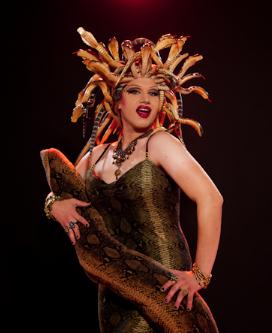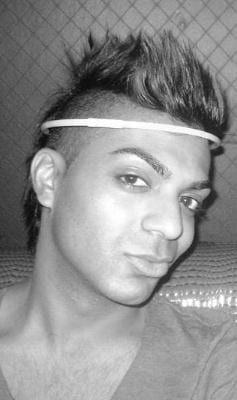
"As an artist I regret nothing, as a person I want to communicate," writes Donnarama.
A burka, flames and a dynamite-stick corset are just as much a part of this drag queen’s set as the lipstick, wigs and eyelashes. But she’s not making any excuses — or apologies.
Donnarama, one of Toronto’s most popular drag performers, is under fire for a Dec 16 Woody’s performance some are calling Islamophobic. The routine, which the entertainer has been performing since at least 2009, has the gay community divided on the line between artistic expression and racism.
“As an artist I regret nothing, as a person I want to communicate,” Donnarama wrote in an email chat Dec 19. “I usually take great pride in my creations . . . But I’m not happy about this, upsetting people is not my intention.”
One of those she upset is 27-year-old social worker Rahim Thawer, who brought the performance to light.
On the night of Dec 16, Thawer wanted to end an average weekend on a high. Attending a Church Street drag show seemed the perfect option. But the Donnarama performance was not what he was looking for. “I’m very aware of the drag world and the way it uses race in different ways,” Thawer says. “But nothing has been quite so appalling.”
To the music of the Pussycat Dolls and Katy Perry, Donnarama sported what she calls a “corset made of dynamite sticks” and a traditional Islamic headdress known as a burka. She also had a bindi spot painted on her forehead, which Thawer says is culturally dissonant to the headdress. The bindi is a traditional South Asian decoration, not Islamic.
Mini explosions, candles and fire lit up Donnarama’s stage as she performed “When I Grow Up” and “Firework,” with choreographed dance moves mimicking the use of a gun.
As Thawer looked around the bar, he was angered to see many patrons filming the performance with their cellphones and approaching Donnarama to reward her with tips. When she began another number in the same outfit, Thawer couldn’t bear it any longer.
He booed from the audience, gave Donnarama the finger, and left Woody’s in tears.
Comforted by friends, Thawer took to social media to share his experience. He wrote a public Facebook note, which was eventually published on The Huffington Post Canada blog, and has received more than 1,200 “likes” as of Dec 21.
“This performance is nothing short of hate speech, racism, and violence,” Thawer wrote. “A community icon basically assaulted me (and the entire queer Muslim/racialized table I was at) and then my queer community sent me the message that this was okay.”
Woody’s has a pre-existing understanding with Donnarama that says she is “not supposed to do anything like that,” says general manager Dean Odorico. She has been spoken with regarding her performance, he says. The freelance performer is not an employee of the bar, and Woody’s staff members were unaware that she would be performing the routine in question, Odorico says.
This isn’t the first time the Donnarama performance has sparked outrage.
In late spring of this year, she performed a similar number to mild controversy at Buddies in Bad Times Theatre, where she is also a regular act. The performance made some staff members uncomfortable, and the theatre received a complaint from a patron. Artistic director Brendan Healy addressed the incident in a public Facebook note Dec 19 in response to Thawer’s post, which called for a boycott of Buddies and Woody’s.
Formal screening policies on performance content do not exist at Buddies, Healy says. The theatre gives its performers the benefit of the doubt that they will adhere to the values that Buddies holds paramount, he says.
“Obviously, drag — and, in fact, queer art — a lot of it is designed to offend, to upset, to disrupt, to critique,” he says. “That’s at the heart of what queer cultural expression is about. That being said, I don’t think queer art is about perpetuating negative stereotypes. It’s a fine line.”
Kevin Nixon, a University of Toronto PhD student researching drag queens, says the line often wavers. “Drag can be used to reinforce particular stereotypes, but it can also be used to transgress those stereotypes.”
Race is not foreign ground in the drag world, with many performers attempting — successfully or otherwise — to make political statements. It needs to be approached cautiously, Thawer says.
“You can’t call it art and good social commentary if you don’t have a message or a critique that is tied in to a larger political conversation,” he says. For Thawer, Donnarama failed to do this.
But the popular drag queen says her performance is, in fact, charged with post-9/11 race politics.
“Suddenly the cowboys had their Indians and the game was on,” she wrote in an email chat about the political climate after the Sept 11 terrorist attacks. “My idea was to present this stereotype as a political parody.”
Though not an excuse, the performer’s intention should be considered, Nixon says.
“It’s not that she went out to create a racist performance,” he says of Donnarama, but that it is “part of systemic and institutionalized racism that exists in the queer community.”
Many agree and consider the performance part of the bigger picture of race relations in Toronto’s queer community. It’s an atmosphere, according to Thawer, of “white gay hegemony.”
In response to Donnarama, Thawer called for a boycott of both Woody’s and Buddies: “Demand an apology and from the establishments, demand some accountability,” he wrote. It’s a move that has been met with criticism from some who deem boycotting the incorrect response.
Toronto drag queen Dolly Jones says a boycott of the Church Street bar has already been happening for years.
“Woody’s is a very predominantly white bar anyway, to the exclusion of many queers of colour,” Jones says. “But I think white queers should stand up and support fellow queers of colour as well.”
Buddies’ Healy hopes the community reacts in a different way, too. Instead of a boycott, Healy says, the community should engage Woody’s, Buddies and Donnarama in a dialogue.
“Boycotting probably won’t work,” Thawer concedes. “I don’t take it back, but I also think people can be critical and challenge each other in different ways.” He suggests initiatives such as public forums or panels, and even a drag event at which ethnically diverse drag queens would perform.
Donnarama is open to joining the conversation too, she says.
“I’ll sit and speak to anyone with any concerns. I am that type of person who listens when people speak.”

 Why you can trust Xtra
Why you can trust Xtra


